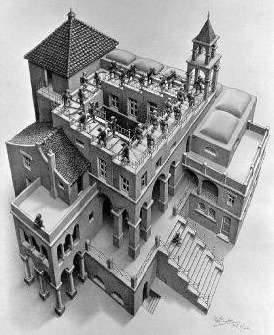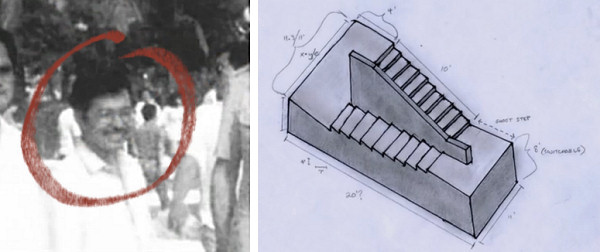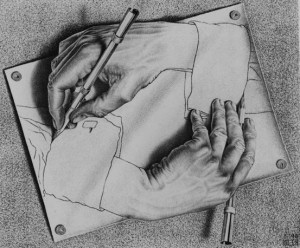What is really mentalism? Wikipedia limits it to
a performing art in which its practitioners appear to demonstrate highly developed mental or intuitive abilities. (1)
In my latest book Te lo leggo nella mente (“I read it in your mind”) I give a broader definition, including performances far more varied and fascinating:
The purpose of mentalism is to create out of ordinary experiences, such as to blur the line between reality and fiction and challenge the classical models with which we interpret reality. (2)
Here are two “mentalistic experiences” that violate the classical Wikipedia definition, not evoking any classic paranormal phenomenon nor mental abilities, but subtly challenging perceptions and offering dreamlike visions. Both seem to be inspired by the famous Dutch artist Maurits Cornelis Escher (1898-1972).

The never-ending staircase, which always brings back to the starting point, is one of the most famous lithograph by Escher. Reinterpreted many times by other artists (i.e. by Christopher Nolan in Inception and by Andrew Lipson in LEGO) the staircase seems to come straight out of a nightmare.
In the 60s the Filipino architect Rafael Nelson Aboganda created a physical version of it at the Rochester Institute of Technology, just before disappearing mysteriously.
The incredible architecture is depicted in a video that opens with the following written in Indonesian language:
Do not use this staircase in case of fire.

Left: Rafael Aboganda Nelson. Right: the project of the scale.
The reason becomes clear soon. Impossible to escape from his disturbing cyclicality:
The whole experience is part of a broader project (“The Stairwell Project: Building a Modern Myth”) coordinated by Michael Lacanilao and described here in detail.

“Drawing Hands” is a most famous Escher lithograph. It stages a “strange loop”: each hand seems to be drawing the other, and both seem to belong to a “higher level”.
It is impossible to sharply draw the boundary between reality and representation, and their edges are blurred, embedding a paradoxical circularity.
This experience, designed by Escher in its most minimal essence, has been brought to an hyperdimensional level by Willie Witte. His video “Screengrab” perceptually challenges the observer: every time you believe you know where you are, a moment later you lose every reference point, asking yourself to which level what you are observing belongs. Willie wrote:
I’m testing an experimental process of printing out still frames from videos and using them to create these transistions. Hope you enjoy. Thank you for watching!
Here it is his spectacular eye candy!
1. http://en.wikipedia.org/wiki/Mentalism (Retrieved on May 3, 2013).
2. Mariano Tomatis, Te lo leggo nella mente, Sperling & Kupfer, Milan (Italy) 2013, p. 11.
BY-NC-SA 4.0 • Attribution-NonCommercial-ShareAlike 4.0 International